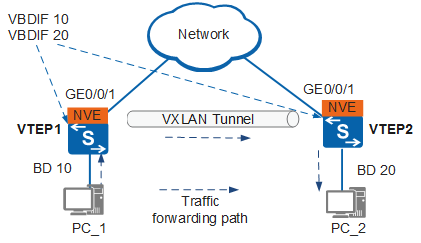Configuring a Layer 3 VXLAN Gateway
Context
When distributed VXLAN gateways are deployed using BGP EVPN, Layer 3 VXLAN gateways must be configured to implement inter-subnet communication.
In distributed VXLAN gateway scenarios, inter-subnet communication between hosts requires Layer 3 forwarding. To allow this, Layer 3 VXLAN gateways must learn host routes. Perform the following operations on VXLAN gateways:
Configure a VPN instance whose routes can be installed into the routing table of the EVPN instance. This VPN instance is used to store host routes or network segment routes, differentiating tenants.
Bind the VPN instance to a Layer 3 VXLAN gateway, enable distributed gateway, and configure host route advertisement.
Configure the type of route to be advertised between VXLAN gateways. VXLAN gateways can send different routing information through different types of routes. If an RR is deployed on the network, only the type of route to be advertised between the RR and VXLAN gateways needs to be configured.

When configuring a VXLAN Layer 3 gateway, choose configuration steps according to the Overlay network IP layer protocol.
When the Overlay network is an IPv4 network, you can choose Configuration of VXLAN Layer 3 Gateway for an IPv4 overlay network.
When the Overlay network is an IPv6 network, you can choose Configuration of VXLAN Layer 3 Gateway for an IPv6 overlay network.
Procedure
- Configuration of VXLAN Layer 3 Gateway for an IPv4 overlay network:
- Configuration of VXLAN Layer 3 Gateway for an IPv6 overlay network:
Follow-up Procedure
The S6720-EI and S6720S-EI switches can decapsulate received VXLAN packets and forward them at Layer 3 only after a VXLAN loopback interface is configured on them. As a result, you need to configure an Eth-Trunk interface as the VXLAN loopback interface when the S6720-EI and S6720S-EI switches function as the Layer 3 VXLAN gateway. Perform the configuration as follows:
Run interface eth-trunk trunk-id
The Eth-Trunk interface view is displayed.
Run service type vxlan-tunnel
The Eth-Trunk interface is configured as a VXLAN loopback interface.
By default, an Eth-Trunk interface is not a VXLAN loopback interface.
Run trunkport interface-type interface-number
A physical interface is added to the Eth-Trunk interface.

After an Eth-Trunk is configured as a VXLAN loopback interface, STP is automatically disabled on the Eth-Trunk. The Eth-Trunk then does not support STP configuration commands. After the configuration is canceled, STP is automatically enabled on the Eth-Trunk.
Only one Eth-Trunk on a switch can be configured as the VXLAN loopback interface. VXLAN packets from all VBDIF interfaces are encapsulated and decapsulated by this loopback interface.
An Eth-Trunk containing member interfaces cannot be configured as a VXLAN loopback interface.
The configurations allowed on an Eth-Trunk to be configured as a loopback interface include description, enable snmp trap updown, jumboframe enable, mixed-rate link enable, qos phb marking enable, set flow-stat interval, shutdown, local-preference enable, traffic-policy (interface view), and trust. If other configurations exist on the Eth-Trunk, the Eth-Trunk cannot be configured as a loopback interface.
After an Eth-Trunk is configured as a loopback interface, the Eth-Trunk supports only the following configurations: authentication open ucl-policy enable, description, enable snmp trap updown, jumboframe enable, mixed-rate link enable, qos phb marking enable, set flow-stat interval, shutdown, local-preference enable, statistic enable (interface view), traffic-policy (interface view), vcmp disable, and trust.
Before running the undo service type vxlan-tunnel command, delete all the member interfaces of the Eth-Trunk interface and all VBDIF interfaces on the device.